Even if people are unfamiliar with the finer details of the sales industry, they have at least heard of the term “B2B sales”. B2B sales, or business to business, is when two businesses make transactions with one another. Rather than selling a product or service to a customer, B2B references a business selling a product or service to another business.
As with other types of selling, the decision making with B2B selling can and should be very analytical. Not just analytical in the sense of tracking how many sales were made and how much revenue was generated, but analytics in the sense of helping track and improve the sales process.
B2B Sales Analytics: Going Beyond Vanity Metrics
As just mentioned, analytics must be in depth and meaningful. At Salesvue, we believe in focusing on metrics that matter, or in other words, avoiding vanity metrics. Vanity metrics would be those such as number of calls placed, total sales and revenue generated. While those are all good numbers to know, they do not tell the full story. They can be misleading. Say Seller A closed 5 deals this quarter and Seller B closed 7. Taking these numbers at face value, one could reasonably say Seller B had a better quarter. However, if you dig deeper into the number, this may be wrong.
What if by looking into metrics that matter you saw that the seller that Seller B had 45 SQLs they talked to, whereas Seller A had 20 SQLs to talk to. This shows more insight into how both actually performed. Seller A converted on 25% of their opportunities, and Seller B closed on around 15% of their deals. Team leaders aiming for better efficiency would then declare that Seller A had a better quarter and may implement some of their strategy across the team or discover what behaviors they may be practicing that could be replicated by others.
B2B Sales Process
Now that you know you must track metrics that matter, here are a few to keep in mind for each step in the sales process.
Prospecting
The first step in the B2B sales process is prospecting. Prospecting, or course, is finding potential customers. This process includes creating buyer personas that are likely to buy your product or service and creating content that will effectively reach them. Here, getting through to the right people is very important. It is very important to track data that gives insight into who to target and with what. A good example of this would be to use a technology, like Seismic, that gives insight into the performance of your content.
With Seismic, you can see how potential buyers are responding to your content. Whether they are reading it or not, what parts they are reading, how long they are spending on content you send them and much more. By combining Seismic with your sales engagement platform, you will not only be able to send content out in a scalable way, but also see if it is truly working or not.
An example of another metric that may be important would be seeing which industries your team has the most success in. By using reports like the ones found in Salesvue’s Math of Sales, you can see which industries lead to the most conversions. If, for example, you had a report like the one below and saw you had more success in the FinServ industry rather than the Healthcare industry, you could put more effort into targeting FinServ.
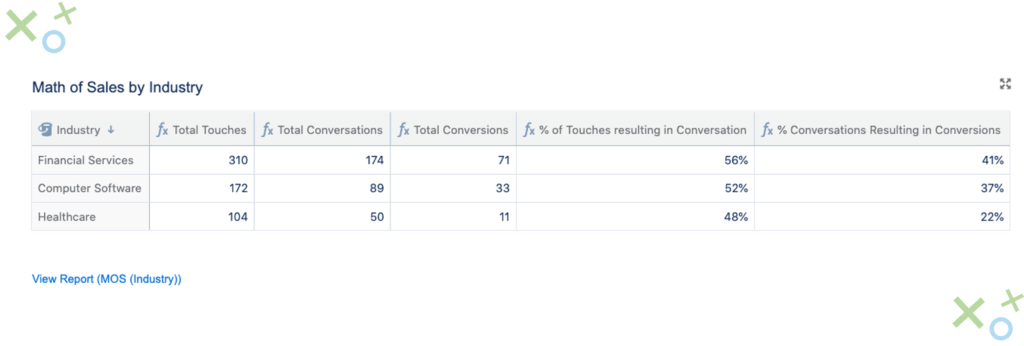
Qualifying Leads
The next step in the B2B sales process is to qualify leads that marketing finds. After content is pushed out, it is up to sales to see who is closest to buying. Knowing whether prospects are in a role to make a purchase decision, in the right time frame to buy, or ever interested in the first place can make or break a deal. In this step, what is most important is to find prospects that are willing and able to close a deal. A good report to use for this step would be a report that filters success by job title.
One of Salesvue’s reports is the Math of Sales Report by Job Function. This report is like the Math of Sales Industry Report. However, this one shows success rates grouped by job title. This will help ensure your sellers are reaching out to those most likely to be in the position to close a deal. While talking to the CEO may seem like a success, it does not necessarily mean the CEO oversees changes to the tech stack.
Nurturing SQLs
The next step is one where using metrics that matter plays a huge role in the success of your team. Like the example from earlier, it is not enough to just see vanity metrics. Nurturing an SQL over days, weeks and potentially months is an essential part in closing a deal. Making a connection with a prospect and winning them away from competitors is vital to the success of your business.
Some key analytics to consider during this stage deal with tracking engagement with prospects. Salesvue has a few recommended metrics to track. One of which being time to first touch. This report shows how quickly your sellers are reaching out to SQLs. This is important because if you leave prospects untouched for too long, they may find another option. Here is an example of what it looks like when grouping by seller.
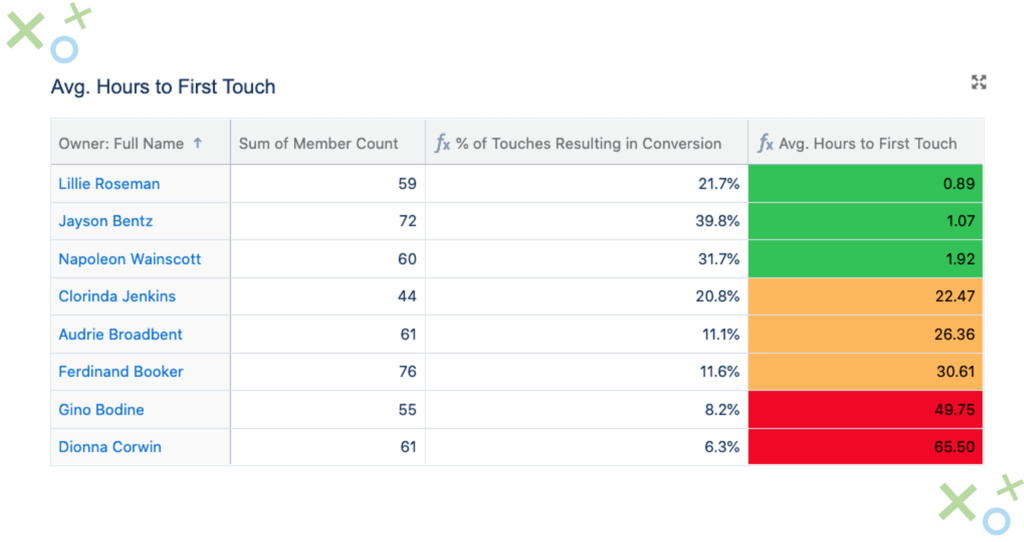
You can also see a similar report that looks at the success of closing a deal by how long it takes to make the first touch. By showing the percent of touches that lead to a conversion by the number of days it took to make the first touch, you can see where any drop-off zones may occur and when your sellers must reach out by.
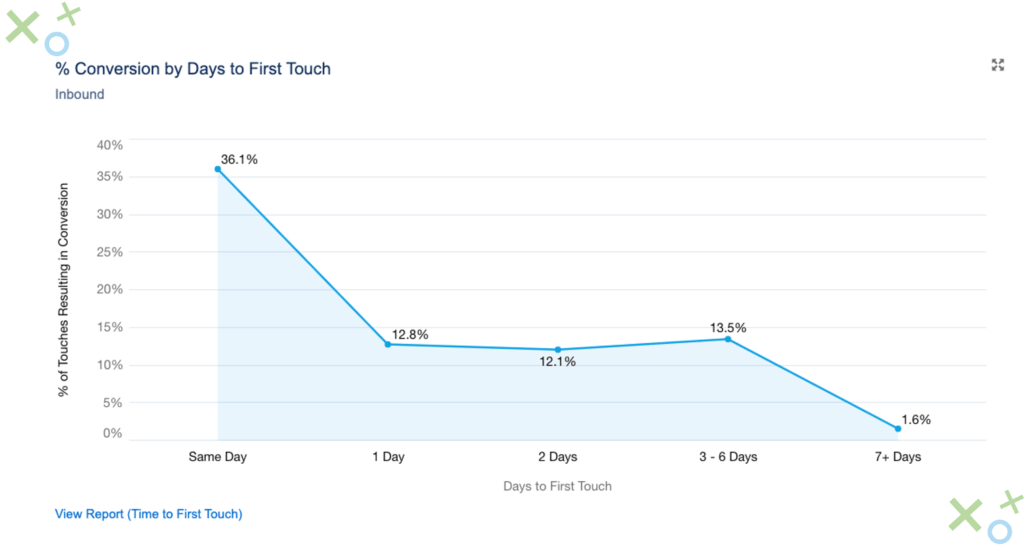
Closing the Sale
The next step in the process is to seal the deal. Once you have prospected, found a lead, nurtured them and successfully connected with them, it is time to close the sale. It is important to stay strong during the stage, as there is always the possibility of things falling through. But, by using proper metrics, you can lessen your chances of this happening. An example of a report that may help during this stage is another Math of Sales report type.
This one highlights Math of Sales by User and shows what percent of conversations lead to conversions for each member of the sales team. This report can help close more deals because it allows team leads to create better practices across the team. In this example, the team lead could replicate Teressa’s practices across the team since she is the most efficient at closing deals. This will help other team members tweak their actions when closing a deal to make them more successful.
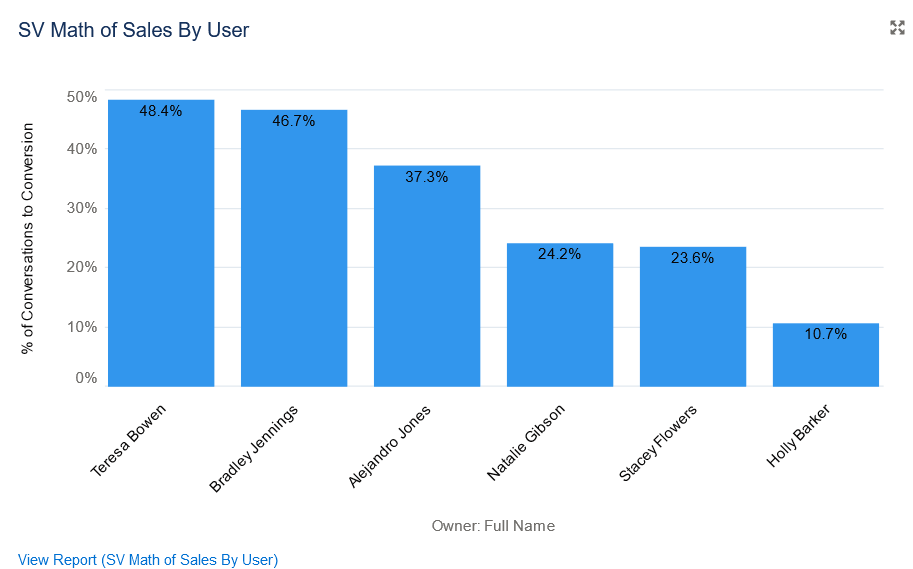
Managing the Account
After you have closed the sale and have a new client, you must not forget about them. Sales is not just always looking for new customers, it is making sure your current customers are happy as well. Some good reports to keep in mind during this stage include those that show how often sellers are reaching out to customers.
In this example, the Conversation Recency Report shows how many days it has been since a seller reached out. This can be important, but it can keep sellers honest in their efforts to maintain a steady relationship with their customers after they close a deal.
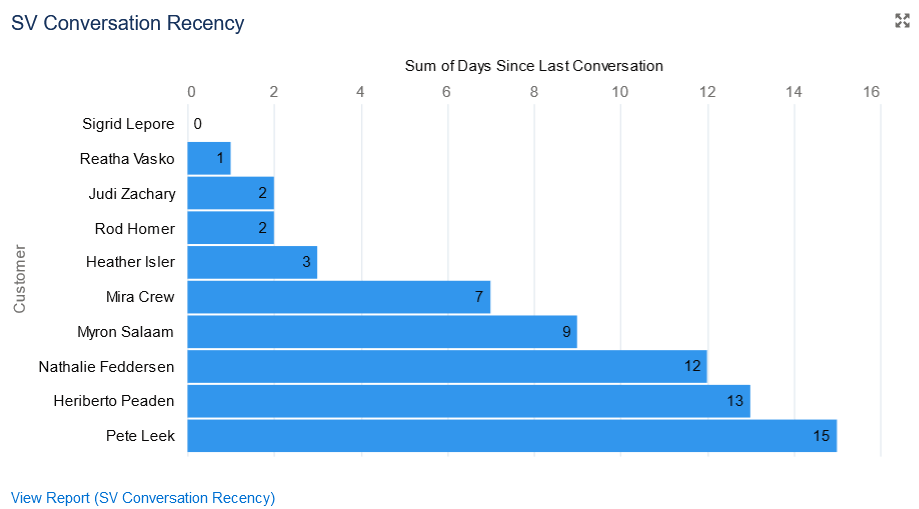
Good B2B Data is Everything
As you can tell, having good data can make or break your B2B sales efforts. Companies do not want to waste their time or resources when finding a new product or service. That is why you must consider metrics that help your efforts be as efficient and effective as possible. On top of this, it is also important to make sure you have good, accurate data.
Single Source of Truth for Reporting
The reports mentioned above would mean nothing if the data in them was wrong. Do not let your company fall into the trap of having great report types, but not being able to use them due to inaccurate, incomplete, or conflicting data. Having your data, reporting, prospecting and more live in a single source can help eliminate the possibility of this. By combining your CRM and sales engagement platform, you can ensure that your data is good data. Moreover, this is made even better by using a CRM native solution, like Salesvue which is a Salesforce-native sales engagement tool.
Good Data for Prospecting Efforts
Another reason having good data is so important is to help with your prospecting efforts. If you are reaching out to bad contact information, you are essentially shooting yourself in the foot. By using tools such as LinkedIn Sales Navigator or Seamless.ai, you can help ensure the data you use in your prospecting efforts is correct.
Future of B2B Sales
At the end of the day, these efforts are to help tweak your processes so you can close more deals. However, it is important to remember not only immediate changes you can implement with your team, but also changes to make to reflect upcoming trends in B2B sales. As you are probably aware, B2B sales often follow B2C sales. But what will this look like in 5, 10, even 20 years? Will sales pitches take place in the metaverse? Will sellers ever go back into the office? Here are some tips:
- Prioritize the seller experience and coaching
- Fully integrate sales and marketing
- Rethink B2B sales enablement
Keeping up with different predictions like these from Forbes and Gartner will help set your team up for success in the many years to come.
Summary
B2B sales is a huge part of the sales industry. That is why B2B sellers must be as efficient and effective as possible. Using proper analytics and metrics that matter can help get sellers to this spot. By utilizing different reports, like those found within Salesvue, can help highlight key pieces to the B2B sales process that must be tweaked. Combining the forces of Salesforce and Salesvue helps B2B sellers continuously improve their efforts so they can close more deals.
Category
Tags
Subscribe to Funnel Vision
Get the latest and greatest right in your inbox






